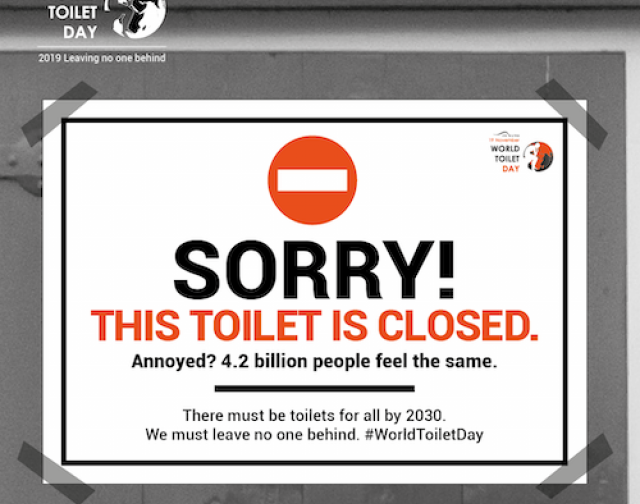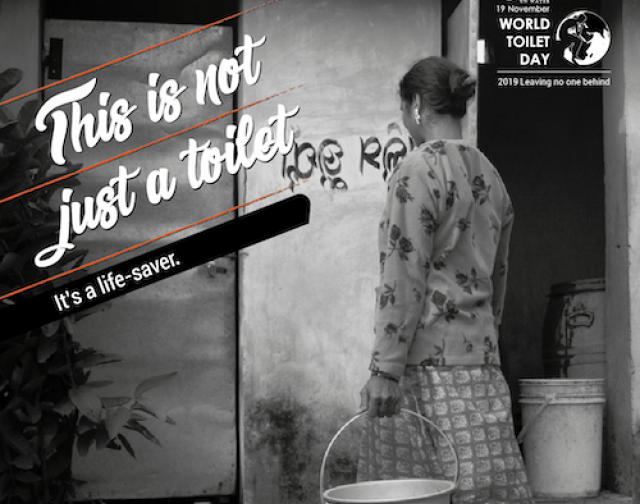World Toilet Day 2019

The theme of World Toilet Day 2019 is ‘Leaving no one behind’, which is the central promise of the 2030 Agenda for Sustainable Development. This year, we want to show that a toilet is not just a toilet; it’s a lifesaver, dignity-protector and opportunity-maker.
We encourage everyone to imagine daily life for the 4.2 billion people without safely managed sanitation and ask how anyone could lift themselves out of poverty without it. We remind the international community that we must leave no one behind as we expand access to safe toilets, because whoever you are, wherever you are, sanitation is your human right.
WHAT ARE THE PROBLEMS WE FACE?
Today, 4.2 billion people live without safely managed sanitation, 673 million still practise open defecation and three billion lack basic handwashing facilities.1 This sanitation crisis means untreated human waste is spreading diseases into water supplies and the food chain for billions of people. Inadequate sanitation is estimated to cause 432,000 diarrhoeal deaths every year.
Globally, the world is off track to meet Sustainable Development Goal (SDG) 6 to ensure sanitation and water for all by 2030. Funding is falling short demand is rising, water pollution is worsening and existing governance structures are often weak and fragmented.
Poor and marginalized people are much more likely to lack safely managed sanitation services and often face many forms of discrimination. They can be left behind as they try to access and manage sanitation services or improve their current facilities.
WHAT IS THE AIM OF WORLD TOILET DAY?
World Toilet Day, celebrated on 19th November every year, is about inspiring action to tackle the global sanitation crisis. Established by the World Toilet Organization in 2001, World Toilet Day was made an official UN day in 2013.
UN-Water leads a taskforce of international agencies to campaign around a common theme. In this year’s World Toilet Day campaign, we encourage a range of actions, including:
- Learning about the issues by reading stories and this factsheet.
- Sharing the issues by using World Toilet Day social media assets to generate debate.
- Taking action by attending or holding an event and using World Toilet Day resources to make change happen.
WHAT IS THE HUMAN RIGHT TO SANITATION?
Recognized as a distinct right by the UN General Assembly in 2015, the human right to sanitation entitles everyone to have physical and affordable access to sanitation, in all spheres of life, that is safe, hygienic, secure, and socially and culturally acceptable and that provides privacy and ensures dignity. International human rights law obliges states to work towards achieving universal access to water and sanitation for all, without discrimination, while prioritizing those most in need.
WHY ARE PEOPLE BEING LEFT BEHIND WITHOUT SAFELY MANAGED SANITATION?
People from different groups are being left behind for different reasons. The following are some of the ‘grounds for discrimination’ that cause certain people to be particularly disadvantaged when it comes to accessing sanitation:
- Sex and gender
- Race, ethnicity, religion, caste, language, and nationality
- Disability, age and health status
- Property, tenure, residence, economic and social status Where these grounds for discrimination combine – or ‘intersect’ – a person’s exclusion or marginalization can be compounded.
Other factors, such as environmental degradation, climate change, population growth, conflict, forced displacement and migration flows can also disproportionately affect marginalized groups and their access to sanitation and water services.
KEY FACTS
- 4.2 billion people live without safely managed sanitation – more than half the global population. (WHO/UNICEF 2019)
- 673 million people still practise open defecation worldwide. (WHO/UNICEF 2019)
- Globally, at least 2 billion people use a drinking water source contaminated with faeces. (WHO 2019)
- Inadequate sanitation is estimated to cause 432,000 diarrhoeal deaths every year and is a major factor in diseases such as intestinal worms, trachoma and schistosomiasis. (WHO 2019)
- Approximately 1.5 billion people worldwide are infected with soil transmitted helminths, which could be completely prevented with sanitation.
- 297,000 children under five are estimated to die each year from diarrhoea as a result of unsafe drinking water, sanitation, and hand hygiene. (WHO 2019)
- Children under the age of five living in countries affected by protracted conflict are, on average, nearly 20 times more likely to die from diarrhoeal diseases caused by a lack of safe water, sanitation and hygiene than by direct violence. (UNICEF 2019)
- One third of all primary schools lack basic sanitation and hygiene services, affecting the education of millions of school children, particularly girls managing menstruation. (UN 2019)
- 1.5 billion people use health care facilities with no sanitation services. (WHO/UNICEF 2019)
- The 70.8 million people who have been forced to flee their home as a result of war and persecution regularly face barriers to accessing safe sanitation and water services. (UNESCO 2019 and UNHCR 2019)
- Only 17% of refugees have access to safely managed sanitation where they live. This is well behind the global average where 45% of the global population have access to safely managed sanitation at home. (UNHCR 2019 and WHO/ UNICEF 2019)
- The wealthier generally receive high levels of WASH services at (often very) low cost, whereas the poor pay a much higher price for a service of similar or lesser quality. (UNESCO 2019)
- Loss of productivity to water- and sanitationrelated diseases costs many countries up to 5% of GDP. (WHO 2012)
- For every $1 invested in basic sanitation in urban areas, an average of $2.5 is returned in saved medical costs and increased productivity. In rural areas, an average of $5 is returned for every $1 invested. (Hutton 2015)
- As the global sanitation workforce increases, sanitation workers should be protected from occupational exposure, such as to injury, asphyxiation and pathogens, through adequate health and safety measures. (WHO 2018)
Resources: http://www.worldtoiletday.info/resources/
Stories: https://www.worldtoiletday.info/theme/4
Social media assets: https://www.worldtoiletday.info/socialmedia/
Event: https://www.worldtoiletday.info/events/





















